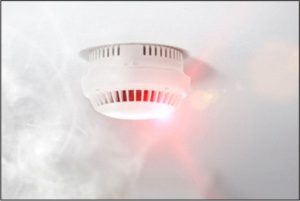 Current capabilities of this aspect of fire and life safety provide advanced and targeted protection
Current capabilities of this aspect of fire and life safety provide advanced and targeted protection
Early detection keeps fire damage small. Today’s fire detection technology can detect a fire in what fire safety science calls the “incipient” stage, when it is still small and controllable, and damage is minimal.
This is particularly important given the fact that many commercial buildings stand empty more than half of each workday, as well as during most weekends and holidays. When there is no one present to pull a fire alarm, the fire may grow to an uncontrollable size before it is even noticed. This may increase the scope of loss of business momentum as well as physical assets.
Intelligent fire detection systems can interface with building control systems to perform critical functions, such as shutting down ventilation blowers, closing fire doors, and opening smoke exhaust systems. (Photos: Courtesy of Encorus Group)
Pinpoint location selection. Previous fire detection systems were on a single circuit. From the control panel, it was difficult to tell which part of the building might have a problem. As a result, fire crews would have to search throughout the building, wasting precious time, and the fire had time to build. In addition, sprinkler systems might be activated for a larger area of the building than needed, causing unnecessary water damage.
Current systems can tell exactly where the fire was detected, allowing for prompt and efficient response while the threat is still small. With less need for firefighters to check the whole building, evacuated staff are able to return to work more quickly, restoring productivity sooner rather than later.
Customized to meet facility needs. The heat plume from a fire lofts into the air the by-products of combustion, which then pass through the detection chamber of the alarm unit and trigger the sensor.
Picking the right kind of detector—one that is matched to the type of combustible materials on the premises—will help ensure a timely response to a fire, while also helping avoid false alarms.
Today’s alarms can be programmed to change their sensitivity according to factors such as the time of day. This works particularly well with businesses that have repair shops and manufacturing areas which produce a dirty atmosphere during the workday, but as the air clears at night, the sensitivity of a detector can be increased.
Modern detection systems can also be interfaced with building control systems to perform critical functions. This includes shutting down ventilation blowers, closing fire doors, and opening smoke exhaust systems. (See sidebar for an overview of common detection technology.)
Risk and cost management. Having a good fire detection system may help reduce insurance costs.
And, remember that many insurance policies cover just the basics of a fire loss, but there are other costs that will not be covered unless specific riders (likely adding to premiums) are added. Of course, the larger goal is to stop a fire before it has a chance to do much damage. This means that fire detection technology is a big part of smart risk management for buildings.
Attract and retain employees and tenants. In the quest to attract and retain top talent, being able to demonstrate caring for employees—by showing how they’re being protected from danger due to fire—can help with staffing goals. In buildings that include tenants, having a good fire detection system can help with tenant relations and improve the building’s competitiveness.
Choosing A Fire Detection System
According to the National Fire Protection Association (NFPA), “the goals for fire detection in any scenario require the use of a detector that will provide the optimum performance in terms of early detection and freedom from false alarms, and remain operationally reliable during its life cycle.”
Some of the factors to consider in selecting a system meeting those criteria are:
- What best suits the application? (Note: Be wary of what might be called “dollar store” systems that meet basic needs but lack reliability as well as the capacity for expansion)
- Are there service companies available locally to maintain, test, and repair systems?
- Can the system be upgraded? If the business expands, can the system expand with it?
- In 15 or 20 years, can parts and components be replaced, and will there be technicians still available who are trained to service that system?
Many states and local authorities require that fire alarm systems comply with NFPA 72, National Fire Alarm Code. This code does not specify where systems must be installed, but it does define how the equipment must be installed to ensure optimum performance. Factors for decision-makers to consider include:
Common Types Of Fire Detection
Ionization-type alarms have radioactive material between two electrically charged plates which ionize the air and cause current to flow between the plates. Smoke entering the chamber disrupts the flow of ions, reducing the current and triggering the alarm.















































